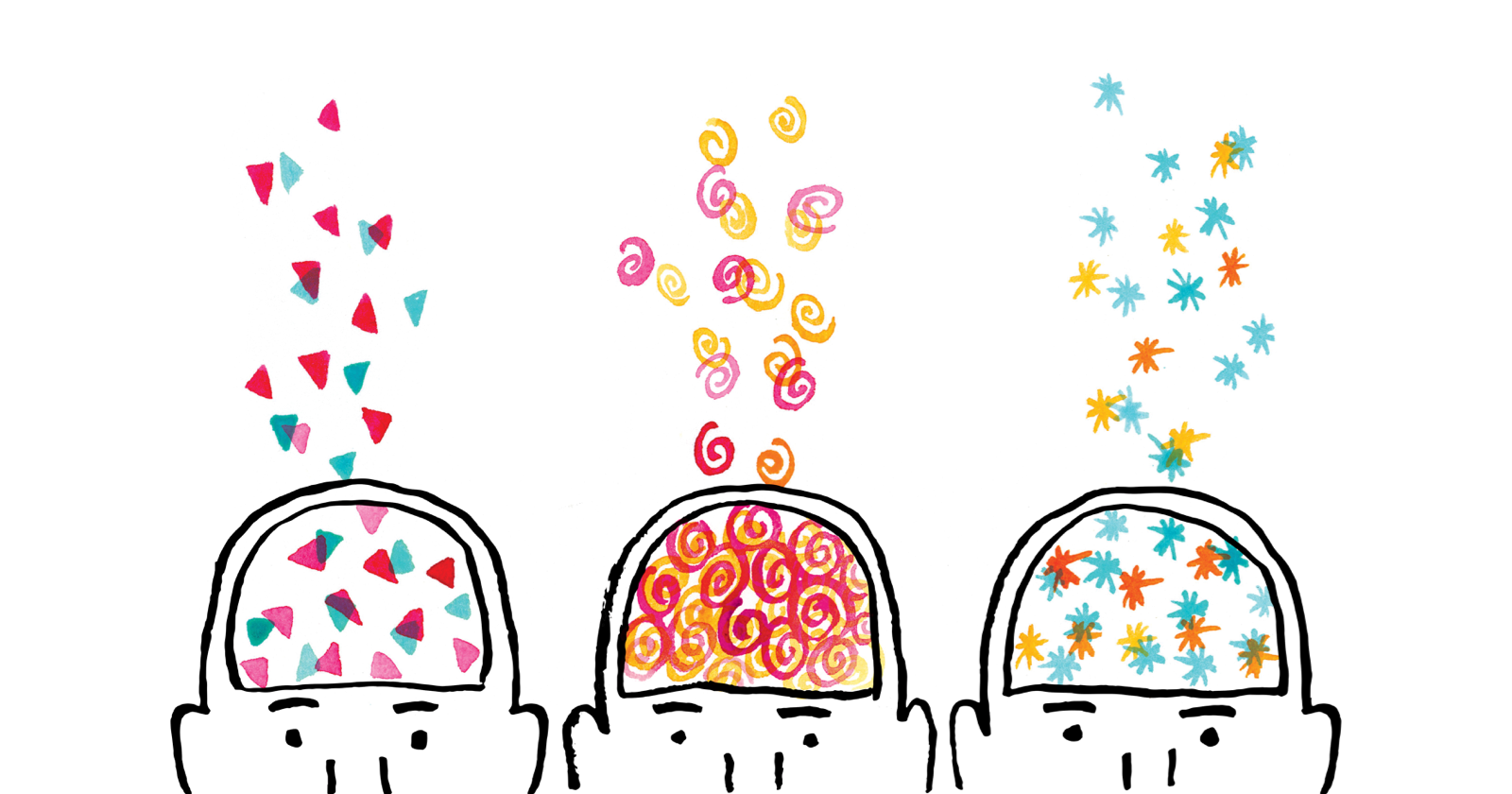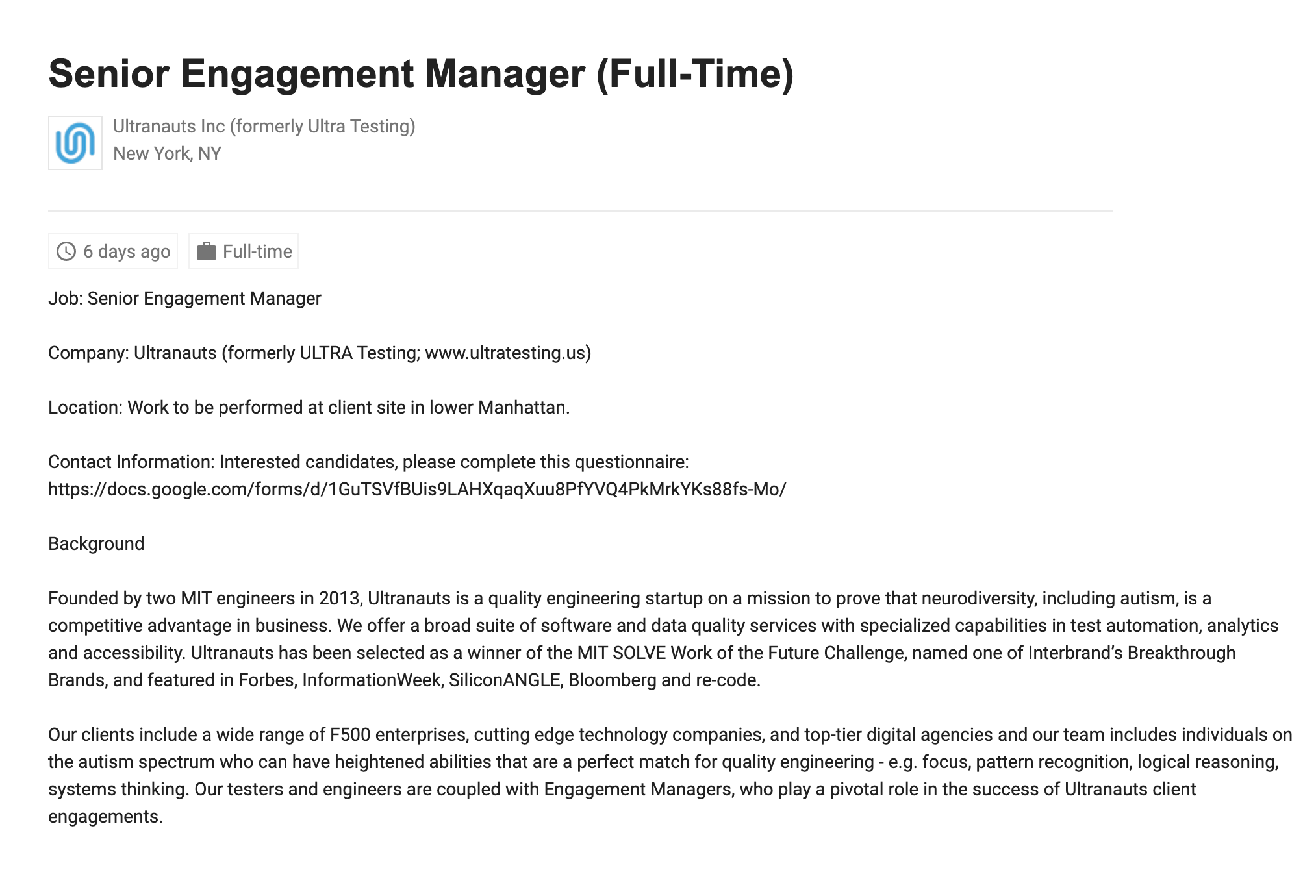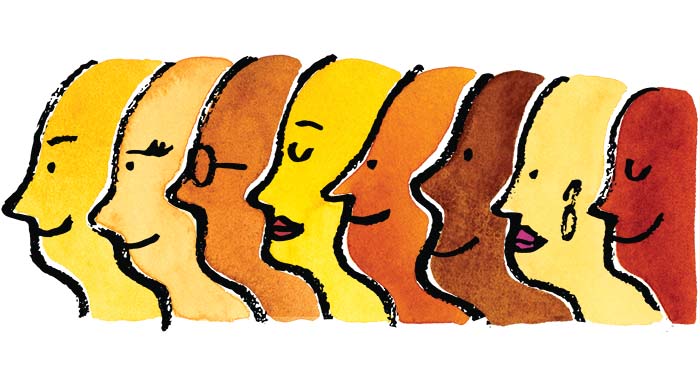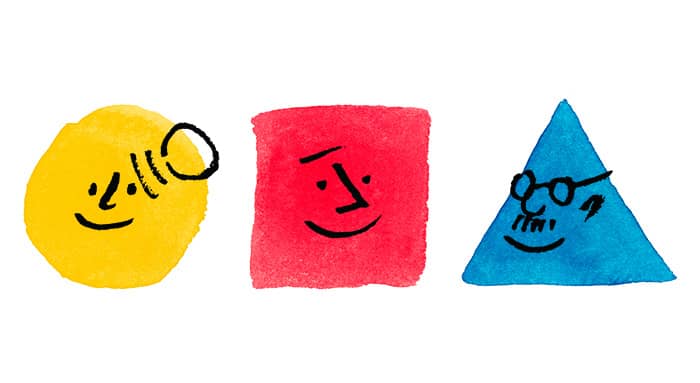
More companies are starting to get serious about neurodiversity—and it’s not about following the HR trend of the day.
As our world becomes more data-driven, the value that differently abled people can bring to your bottom line can be a true game-changer for your business.
It’s time to ask yourself:
Are you doing everything you can to make your company inclusive to neurodivergent talent?
Whatever your answer, luckily the solution to making your company more diverse really isn’t that hard.
From shifting the language you use to making small, candidate-centric tweaks to your recruitment processes, there are plenty of easy wins to make sure your company benefits from neurodiversity in the workplace.
The trick is to start small.
In Thomas Armstrong’s book, The Power of Neurodiversity, he encourages people to get on board with the idea that there is no such thing as a “standard brain”.
According to experts like Armstrong, a first baby step in the right direction is to steer clear of negative language when discussing topics related to neurodiversity. One of the most glaring examples is the double use of negative words used to describe ADHD: deficit and disorder.
These might seem like small things, but they can lead to big bias—bias that, if left unchecked, can destroy your ability to compete.
So if the idea of neurodiversity is still a big black box for you, read on. This foolproof guide will tell you everything you need to know to attract and retain the best neurodiverse talent.
First, the FAQs
What is neurodiversity?
The term neurodiversity refers to the infinite range of human behavioral traits and brain function.
(If you think about it, it’s a pretty rad word. 😎)
Everyone to some extent is neurodiverse depending on their individual experiences. But the term is usually used to describe people whose talents stand out and (sometimes) that means they need extra support, such as people with autism, dyslexia, ADHD and other neurological conditions.
In an article for Psychology Today, bestselling author John Elder Robison says, “Neurodiversity is the idea that neurological differences like autism and ADHD are the result of normal, natural variation in the human genome.” Robison is co-chair of the Neurodiversity Group at the College of William & Mary and is also the university’s Neurodiversity Scholar in Residence.
As someone with Asperger’s syndrome, Robison is one of many autistic adults who have higher than average intellectual capabilities but lack the social skills most of us take for granted.
For people like Robison, that could mean missing out on job opportunities simply because they struggle to make eye contact in interviews, or find it hard to get past personality tests.
“Indeed, many individuals who embrace the concept of neurodiversity believe that people with differences do not need to be cured; they need help and accommodation instead,” says Robison.
We couldn't agree more.
But if you or your internal stakeholders need a little more incentive to make those accommodations, we got you covered.
Thomas Armstrong’s book, The Power of Neurodiversity is a must-read for any people leader who is serious about D&I.
What are the benefits of attracting neurodiverse talent? (Hint: They're BIG)
It takes all kinds of plants to make a garden—and diversity can help your company blossom too. 🌷
In fact, inclusive companies are 1.7X more likely to be innovation leaders, plus 1.8X more likely to be able to cope with change.
And when it comes to neurodiversity, the stats are off the scales.
According to executive director and head of JP Morgan’s ‘Autism at Work’ program, James Mahoney, “Our autistic employees achieve, on average, 48% to 140% more work than their typical colleagues, depending on the roles.”
That’s huge.
With an 85% unemployment rate among people with autism, this is a massive untapped pool of highly skilled workers with proven abilities. And all it takes to benefit from this pool of rockstar candidates is to roll out the welcome mat and let them know you get it.
Here are some key benefits neurodiverse talent can bring your business:
- Outside-the-box thinking and innovation: By now, we all know diversity breeds innovation. Increase neurodiversity and you’ve got an even better chance of outrunning your competition.
- Increased understanding of your audience: According to the Centers for Disease Control and Prevention (CDC), 1 in 68 US children have autism. That’s 1 in 68 of whoever your audience/customers/service users are. Recruit neurodiverse people to your teams and you’ll immediately gain a better understanding of the people you’re catering to. It's that simple.
- Natural born problem-solvers: Neurodiverse people often have awesome technical and analytical skills as well as the ability to focus down on the minute detail most people would miss. Think data management, analysis or problem solving—all the things that make a modern business tick.
According to the Forbes Innovation through Diversity report, most companies are still focused on gender and ethnicity for their D&I efforts.
Do other companies have neurodiversity programs?
The answer to this one is a big fat YES.
When it comes to the wild world of talent, you can learn a lot from international megabrands.
Microsoft, Ford, IBM, Goldman Sachs, JPMorgan Chase, SAP and Hewlett Packard Enterprise have all launched neurodiversity initiatives—just to name a few.
In fact, SAP is already seeing returns on their neurodiversity campaign by way of increased employee engagement and productivity, improvements in product quality and an increase in company-wide innovations.
Meanwhile, Australia’s Department of Human Services (DHS) neurodiverse software-testing teams were proven to be 30% more productive than their counterparts. Boom!
And yet another impressive group comes from none other than the Israeli Defense Forces (IDF). (And you KNOW those guys don’t mess around! 💪🏾)
The IDF has a team called the Special Intelligence Unit 9900 composed mainly of people on the autism spectrum. This highly specialized unit of neurodiverse badasses analyze aerial and satellite imagery and can spot patterns others wouldn’t normally see.
How freakin’ cool is that?
What can I do to promote neurodiversity in the workplace?
Step 1: Figure out the best roles for neurodiverse candidates
Neurodiverse candidates will have some amazing skills, but it's likely that many of them will only feel comfortable in certain types of roles.
- Take a step back and think about which areas of your company could potentially benefit from the types of skills a neurodiverse person would bring.
- Ask yourself what a neurodivergent person would be best at. For example, autistic people tend to be very focused on minute details so might be best placed in an analysis or problem-solving role.
- Decide whether you already have the perfect role for them or if you need to tailor a role specifically for the candidate. For example, if you have a great analytical role perfect for but it also requires the interpersonal skills they may struggle with, consider splitting the job description in two.
- Finally, check in with the team and explain why bringing a neurodiverse candidate on board will help their team blossom.
Getting the right person for the job is a no-brainer—but when you’re looking to benefit from some ace neurodiverse talent, it’s also important to make sure you have the right job for the person.
Step 2: Write clearer job descriptions and ads
Simple, right?
Yet who among us is truly willing to give up our overstuffed skills list and compensation-dodging verbiage?
A great job description gets applicants excited about your diverse company culture, while being unmistakably clear about the values that shape your expectations for the role.
And they’re even more crucial when recruiting for neurodiversity.
Here are a few tips for writing job descriptions and ads that catch the eyes of neurodiverse talent:
- Avoid the fluff and jargon at all costs.
- Refrain from generic job descriptions that resemble overwhelming wishlists.
(If we’re being really honest, an excellent programmer probably doesn’t need to have great people skills.) - Clearly state that your organization welcomes neurodiverse talent.
Nicole Whiting, COO at cybersecurity firm Titania, made important changes to the recruitment process with the specific goal of attracting neurodiverse talent.
“We completely changed our job adverts after speaking to people on the spectrum. We used to say we were inclusive and would take anyone as long as they could do the job. What we found was that unless you specifically said ‘neurodiverse’ or ‘autism’ they didn’t apply.”
Word choice is always important. Perhaps even more so for neurodiverse talent who have been historically ignored and underrepresented in the labor market.
Here's a super simple example of a job description that clearly states its desire for neurodiverse applicants:

Step 3: Create a neurodiverse-friendly employer brand
Whether it’s sharing a story on your Facebook page or interviewing an autistic employee for your company website, highlighting neurodiversity is probably not as hard as you think.
Compared to physical disabilities, neurodiversity is often less visible and more stigmatized. But with autism rates estimated at a minimum of 1 in 68 people, there’s a good chance you already have neurodivergent people working for you who either haven’t been diagnosed, or aren’t comfortable sharing their diagnosis.
If you already have existing programs aimed at creating an inclusive environment for people with special abilities, simply add testimonials or real-life stories featuring your neurodiverse employees. If you’re new to the idea, show your neurodiverse employees you’re ready to listen and learn.
Sometimes the best “branding” move you can make is to simply commit to learning more about your target audience.
Big names like Microsoft, SAP and EY are aware of the “untapped pool of talent” and have piloted programs aimed at not only recruiting neurodiverse individuals, but also determining what types of roles and work environments support them best.
Step 4: Fix your recruitment and selection process
Without a physical reminder of how neurodiverse people are different from neurotypical people, it can be tempting to follow the same selection process you use for everyone.
But if you wouldn’t expect a person in a wheelchair to stand up and shake your hand, why would you expect an autistic person to look you in the eye?
Dr. Jill Miller, Diversity and Inclusion Adviser at the CIPD says, “recruitment and development practices are screening out such individuals and the unique skills they possess. Rather than measuring potential employees against a long wish list of capabilities, we need to be clear on the key skills each job requires and enable people who possess those to play to their strengths.”
Luckily, there are plenty of ways to cater to neurodiverse individuals when hiring.
Here are just a few small things that can make a big difference:
- Simplify your forms and interview questions to avoid confusion.
- Rock your candidate meet and greets.
- Make sure all your policies are written clearly.
- Use images to illustrate duties where possible.
- Offer awareness training to everyone from your front-liners to the tippity top-level managers.
- Mitigate losing out on neurodiverse talent by shortlisting at least two neurodiverse candidates for the role.
- Make sure to offer appropriate, useful feedback to candidates.
And remember, most cultural changes fail due to the gap between the folks at the top and those on the ground. Make sure your leaders know how and why they should show their support for a diverse workforce.
Step 5: Walk your talk
Attracting neurodiverse talent won’t do much for your company if you don’t have the onboarding chops to keep that talent around.
Workplace accommodations are key to creating a productive and recognition-rich environment for everyone, especially your neurodiverse employees.
Here are a few things you can do to accommodate neurodiverse team members:
- Provide headphones to those who suffer from ADHD to prevent auditory stimulation.
- Avoid excessively bright lights that can lead to sensory overload.
- Consider modifying work hours. Focus on output delivered instead of time rendered.
- Offer desk assessments: Are their screens too bright? Do they need filing drawers to organize their personal belongings?
- If you’re not sure what else they need, ask!
As a general rule of thumb, it's always a great idea to conduct regular one-on-ones to help you and your managers understand your neurodiverse team members better and make the right kind of change to both your recruitment and retention strategies.
Neurodiverse Talent: Why it's time to kill the stigma
By now, we've seen that oosting neurodiversity could bring your business a 30% increase in productivity and help you connect more deeply with your customers.
But unfortunately, candidates with special abilities don’t usually fit the profile prospective employers are looking for.
A recent poll by the Chartered Institute of Personnel and Development (CIPD) shows 72% of HR professionals don’t consider neurodiversity in their people management practices. In fact, 17% had no idea what the word “neurodiversity” even meant.
The good news is, that leaves a ton of room for you to jump ahead of the competition. 🎉
With a little tweaking of your current systems, and some serious work when it comes to understanding the needs of neurodiverse talent, you could be in for a big productivity win.
For you and the neurodiverse individual who’s been consistently ignored by the workforce, the impact of an inclusive workplace is huge.
So if you’re not already on board, now is the time—after all, just imagine what you could be missing.





